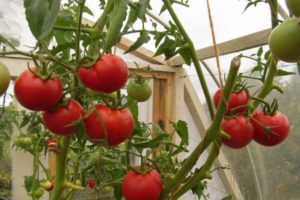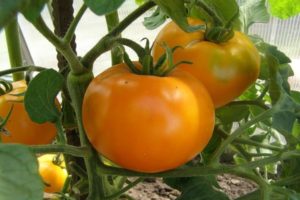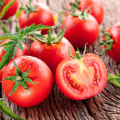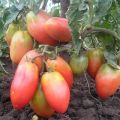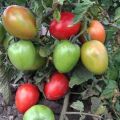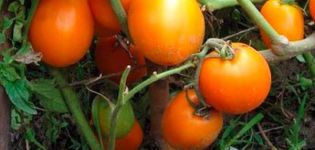Characteristics and description of the Chio Chio san tomato variety, its cultivation and yield
Chio chio san tomatoes are an excellent choice for growing in all climatic zones. Its exclusivity is not only in high yields of fruits, but also in excellent taste.
Before sowing a tomato, you must read reviews of the selected variety of garden plant. It is important to know the main characteristics of the vegetable, the conditions for its cultivation.
The main properties of tomato
The Chio Chio San variety has been popular for a long time, it was bred back in 1998. Its small, plum-like fruits are great for canning. And the ripening period of tomatoes falls on the beginning of August, when harvesting for the winter is massively going on.
The characteristic and description of the variety includes the following indicators:
- On tall bushes, reaching two meters in length, oblong fruits are formed by tassels.
- The f1 hybrid has a dessert flavor, fleshy pulp, thin pink skin.
- On one brush, you can count up to fifty fruits, each weighing about forty grams.
- From a bush, the yield reaches five to six kilograms.
- A first-generation hybrid, tomato is protected against common fungal diseases.
- The ripening period of a tomato is 100 - 120 days after the first shoots appear.
- The crops are harvested on time, without leaving a long time on the branches, as the chio tomato will begin to crack.
The fruits removed from the bushes in time are stored for a long time, they tolerate transportation well.

Chio chio san tomatoes take root well and bear fruit in any climatic conditions, they are not afraid of either heat or moderate temperatures. They give high yields in the open field, in the greenhouse.
Preparatory work and planting of an indented variety
Like any hybrid varieties, growing chio chio san is simply a seedling method. Seeds for planting are prepared in advance by purchasing them in specialized stores. The stages of planting a tomato include:
- rejection of seed;
- soaking seeds in a solution of potassium permanganate;
- hardening them in the refrigerator;
- preparation of containers with nutritious, loose soil;
- embedding seeds in the ground;
- picking after the appearance of two or three true leaves.
In order for the seedlings to appear on time and to be strong, it is necessary to water them as the top layer of the soil dries up.
Rules for planting in open ground, care
As soon as warm May days come, boxes with grown seedlings are exposed to the open air, first for several hours. The hardening procedure is lengthened gradually, leaving the chio tomatoes overnight on the balcony or veranda.
Seedlings are planted in open ground when the threat of night frosts on the soil has finally gone. Seedlings are transplanted into the greenhouse in late April - early May. Moreover, young shoots should have a developed root system, a strong stem, and the appearance of the first ovaries.
For the convenience of caring for tomato bushes, they are placed with ribbons with a distance of eighty centimeters between them, in two lines with a distance of fifty. It is necessary to add humus, wood ash to the planting holes, from which it is easy for vegetable plants to absorb phosphorus. Tomatoes respond well to deep planting, developing an additional root system in loose soil. After planting, young bushes are watered using three liters of water per plant.
To prevent fungal diseases, two weeks after planting, the vegetable crop is sprayed with Bordeaux liquid.
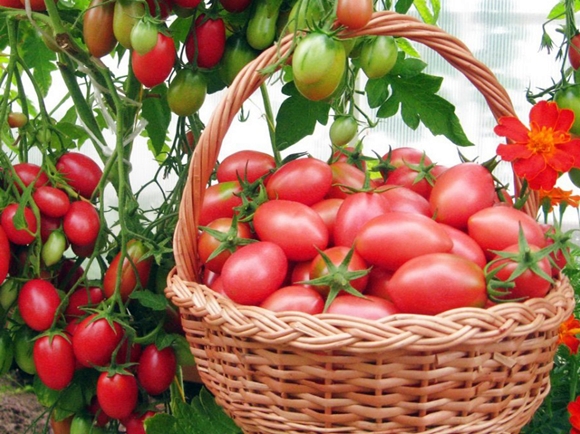
Given the rapid growth of tomato stems chio chio san, after planting the shoots, it is tied to pegs or trellises. This procedure has to be performed several times over the summer, as the bushes grow in height. The garter will save the stems from brittleness under the weight of the fruit bunches.
Proper cultivation of a tomato includes:
- moderate watering of the bushes up to twice a week;
- fertilization at intervals of three weeks, alternating organic with mineral;
- cutting off the stepsons at the bottom of the stem;
- pinching the top of the shoots at the end of July;
- loosening the soil, weeding;
- picking fruits as they ripen.
For tomato bushes grown in a greenhouse, it is necessary to carry out regular ventilation, adjusting the temperature regime of a closed room. Increase the yield of tomatoes by feeding with a mullein solution in a ratio of 1: 8, ammonium nitrate, taken in an amount of fifty grams per bucket of water. With a lack of phosphorus, expressed in a purple tint on the leaves, the plants are watered with a solution of wood ash (75 grams per bucket of water).
The Chio Chio San variety is suitable for fresh consumption, summer salads. There are few seeds, liquid in tomatoes. The description of the fleshy fruits speaks of a pleasant taste, a wonderful aroma of a vegetable, which they give to various dishes, canned food.

For the winter, sauces and juice are prepared from small tomatoes. They are suitable for pickling, pickling, as the integrity of the fruit is preserved after hot processing.
Gardeners about chio tomatoes
Fans of chio chio san tomatoes highlight the following advantages of vegetable crops:
- Shrubs are especially suitable for greenhouses. They do not get sick, easily tolerate heat. The fruits set well in partial shade.
- Even when planting a minimum number of shoots, the yield of small fleshy fruits is enough to prepare blanks for a small family.
- They love to eat delicious tomatoes in salads, children enjoy fresh.
- Tomatoes ripen together. Each brush asks for a jar.
- For those who are engaged in the cultivation of vegetables for commercial purposes, the variety is especially suitable, since the fruits have a high marketable appearance, do not crack, do not break during transportation.
The appearance of the variety, its wonderful taste, high yields have led many to choose it for cultivation in personal plots.
